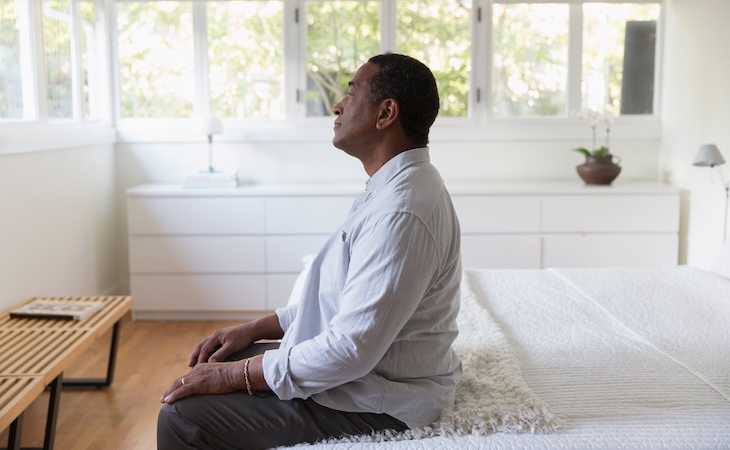We’re pretty sure most of you can relate to this scenario: You get home late after a long day at the office, still reeling from an argument with your stubborn boss. You throw together a quick dinner and hop into bed, trying to drift off as fast as you can because you’ve booked a Pilates class at the crack of dawn tomorrow. But the harder you try to fall asleep, the further away you get from entering dreamland. To avoid this scenario next time around, try a simple yet effective sleep-inducing strategy: slow, deep breathing.
How deep breathing helps you sleep
Deep breathing helps you fall asleep because it calms you down by acting on certain components of your nervous system, says sleep medicine specialist Robert Rosenberg, DO. These components—the sympathetic nervous system and parasympathetic nervous system—play opposite roles. The sympathetic nervous system, dubbed the “fight or flight system,” prepares you to deal with emergencies by triggering your blood pressure and heart rate to go up. The goal of the parasympathetic nervous system is to calm you down.
When you take slow, deep breaths, you activate special receptors, called stretch receptors, in your lungs. These receptors send signals to the brain to put the brakes on the fight or flight system, Rosenberg explains. When you exhale using the slow deep breathing technique, you also trigger the parasympathetic nervous system. As a result, slow deep breathing serves as a double whammy to any residual stress or anxiety that stands between you and peaceful shut-eye. In more technical terms, the technique encourages your body to decrease the production of stress hormones, such as cortisol.
Even though this breathing strategy may seem suspiciously basic, there is solid scientific evidence supporting its magic powers. For example, as Rosenberg notes, some research of slow deep breathing during meditation has shown that the technique may slow down a person’s brain waves. Normally, when people are awake, they have a lot of fast brain waves (a frequency of about 15 cycles per second). “But when we breathe slowly, we start to see more waves associated with sleep, such as Alpha waves, which are about 12 to 13 [cycles per second],” Rosenberg says.
On top of that, focusing your attention on breathing and counting may simply help to redirect your mind away from daily worries, says Terry Cralle, RN, certified clinical sleep educator. “You’re not thinking about things you needed to do at work,” she says. “You’re not thinking about cleaning the house or your to-do list.”
Slow deep breathing may be particularly helpful for people suffering from pain issues, which in turn affect their sleep, Cralle notes. In a study published in the journal Pain Medicine, researchers found that the technique helps to attenuate the perception of pain.
A simple deep breathing exercise for better sleep
Both the “slow” and “deep” components are crucial, Rosenberg points out. To accomplish the former, you need to reduce the number of breaths you take to six to eight per minute from the usual 12 to 20.
Rosenberg recommends breathing in on a count of four and breathing out on a count of six. “Deep” breathing means that you should breathe by engaging your diaphragm—the dome-shaped muscle that sits at the base of the lungs—which helps to deliver oxygen to the hard-to-reach bottom parts of the lungs. In other words, let your belly fully expand as you breathe in (the total opposite of tucking in your tummy to flaunt your abs).
If you want to try slow deep breathing, Rosenberg shares this simple exercise:
- Sit up or lie down in bed.
- Put your hands under your ribs. Breathe in through your nose on a count of four, trying to do so consciously with your abdomen expanding instead of your rib cage. In other words, you should feel your abdomen going up as you breathe in.
- Exhale through your nose on a count of six. The longer exhalation is key to deep breathing’s calming effect.
As you are performing the exercise, try to focus on your breathing and nothing else. If you can’t breathe through your nose, breathing through your mouth is fine too, adds Rosenberg. Getting the hang of the technique may take a few tries, so be patient. Once you do get it down, you’re just a few breaths away from catching much-needed Z’s.
CBD is super-trendy these days, but can it help you sleep better? Here’s what experts have to say about CBD and sleep.




